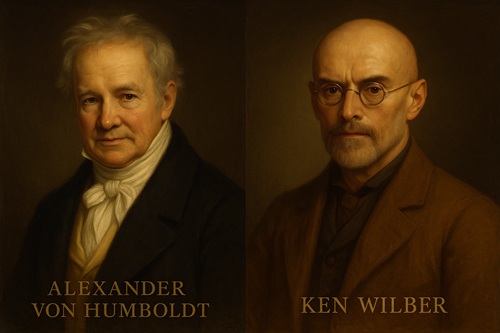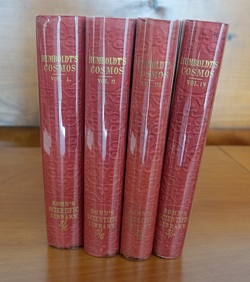|
TRANSLATE THIS ARTICLE
Integral World: Exploring Theories of Everything
An independent forum for a critical discussion of the integral philosophy of Ken Wilber
  Frank Visser, graduated as a psychologist of culture and religion, founded IntegralWorld in 1997. He worked as production manager for various publishing houses and as service manager for various internet companies and lives in Amsterdam. Books: Ken Wilber: Thought as Passion (SUNY, 2003), and The Corona Conspiracy: Combatting Disinformation about the Coronavirus (Kindle, 2020). Frank Visser, graduated as a psychologist of culture and religion, founded IntegralWorld in 1997. He worked as production manager for various publishing houses and as service manager for various internet companies and lives in Amsterdam. Books: Ken Wilber: Thought as Passion (SUNY, 2003), and The Corona Conspiracy: Combatting Disinformation about the Coronavirus (Kindle, 2020).
Check out my other conversations with ChatGPT
The Volume That Never WasKen Wilber's Kosmos Trilogy and the Problem of CompletionFrank Visser / ChatGPT
In both cases, incompletion became not a failure, but a consequence of their own intellectual honesty.
Ken Wilber's Kosmos Trilogy was introduced as one of the most ambitious philosophical undertakings of the late 20th century. The first volume, Sex, Ecology, Spirituality (1995), promised the beginning of a sweeping three-part vision that would unite the insights of science, psychology, philosophy, and spirituality under the banner of “Integral Theory.” But the second volume, though long announced, was never published in full. Instead, a series of dense and exploratory “Excerpts” were made available online between 2002 and 2006, fragments of a vision that was never fully consolidated. These texts—complex, often brilliant, sometimes contradictory—stand as a substitute for a volume that remained unwritten. In this, Wilber finds an unlikely historical parallel in the figure of Alexander von Humboldt, the 19th-century Prussian polymath whose own magnum opus, Kosmos: A Sketch of the Physical Description of the Universe, also remained unfinished despite decades of labor.[1] Though separated by time and discipline, both thinkers attempted to articulate a unified theory of the world—one through the lens of consciousness and interiority, the other through natural science and empirical exploration. And both ultimately discovered that the ambition to represent the whole may be structurally impossible. The Architect: Ken Wilber and the Vision of IntegrationKen Wilber, born in 1949, is known for constructing one of the most wide-ranging philosophical systems of the modern era. He began his intellectual journey by integrating insights from Eastern spirituality and Western psychology, gradually expanding his framework into what he called “Integral Theory.” This model sought to harmonize multiple domains of knowledge—science, ethics, art, mysticism—into a single coherent vision. His early work gained attention for its lucidity and depth, but with Sex, Ecology, Spirituality, he ventured into truly encyclopedic territory. That book introduced the AQAL framework (All Quadrants, All Levels), which aimed to map reality across four basic dimensions: the subjective, intersubjective, objective, and interobjective. The book was intended to be just the first in a trilogy. The second volume would deepen the theory by exploring post-metaphysical spirituality, gender theory, and the evolutionary trajectory of the Kosmos itself. Yet despite repeated announcements, Volume 2 never appeared as a published book. What surfaced instead was a series of loosely connected online writings—highly technical, occasionally provisional, and often promising more than they delivered. These “Excerpts” have become, in a sense, the shadow of the book Wilber never finished. The Explorer: Alexander von Humboldt and the Romantic Science of the Whole
Alexander von Humboldt (1769–1859) was one of the last truly encyclopedic minds of the Enlightenment. An explorer, geographer, naturalist, and philosopher, he undertook expeditions across Latin America and Russia, collecting data on plants, animals, climates, and geophysical phenomena. But Humboldt was not content with simple accumulation of facts. He sought to express the interconnectedness of all natural phenomena, weaving together scientific observation, philosophical reflection, and aesthetic appreciation. His life's work culminated in Kosmos, a multivolume treatise that aimed to present the universe as a unified whole. The first two volumes were widely acclaimed and translated into many languages, blending astronomy, geology, meteorology, and art in a way that resonated with both scientific and literary audiences. Yet as Humboldt aged, the scope of the work ballooned beyond manageability. The later volumes became increasingly digressive, and the fifth was left incomplete at his death. Humboldt had set out to sketch the full tapestry of nature; what he left was a remarkable but unfinished canvas. Two Kosmoses: A Shared AmbitionWilber and Humboldt were separated by two centuries and radically different intellectual climates, yet they shared a core aspiration: to articulate a vision of unity. For Humboldt, the universe was a vast but harmonious web in which every part influenced every other, from mountain ranges to cloud patterns to the poetic sentiments evoked by natural beauty. Wilber, too, conceived the Kosmos as a multidimensional reality—one that included not only physical matter but also minds, cultures, values, and spiritual depths. Both men used the term Kosmos not in the modern scientific sense of physical cosmos, but in the older, philosophical sense of an ordered and meaningful totality. In their own ways, each attempted to trace a path from scattered data points—be they sensory, cultural, or mystical—toward a higher synthesis. Yet both found that the closer they came to that synthesis, the more elusive it became. Fragments of a Grand Design: Wilber's ExcerptsIn 2002-2003, Wilber released a series of long-form essays—labeled Excerpts A through G—that were meant to form the backbone of the missing Volume 2. These writings cover an expansive range of topics: how multiple methodologies can be integrated into a unified map of knowing (Integral Methodological Pluralism), how subtle energies operate within human development, how religion can modernize without losing its soul, and how perspectives—not atoms or minds—might be the true building blocks of reality.
But rather than forming a coherent sequel to Sex, Ecology, Spirituality, these Excerpts read more like exploratory drafts. Some revisit earlier concepts, others introduce entirely new ones; some challenge prior formulations, while others seem to promise further clarifications that never arrive. The effect is at once tantalizing and frustrating: the reader is invited into a dazzling architecture whose final shape remains hidden. This is not unlike Humboldt's later Kosmos volumes, which also became more essayistic and speculative over time. As the initial structural clarity gave way to sprawling reflections, the dream of total synthesis began to fragment.[2] Why the Kosmos Couldn't Be FinishedWhat prevented these two thinkers—each brilliant in their own right—from completing their masterworks? A few common challenges stand out. a. Expanding Complexity Both Humboldt and Wilber were trying to integrate a rapidly expanding body of knowledge. For Humboldt, the growth of specialized scientific disciplines meant that no single person could encompass it all. Wilber, too, was working at the edge of multiple domains—neuroscience, developmental psychology, comparative religion, postmodern philosophy, systems theory. Each time he introduced a new layer to his Integral model, it raised new questions that demanded further elaboration. The system began to multiply itself into ever more complex configurations. b. Shifting Epistemologies Wilber's philosophical evolution added further complications. In the early 2000s, he moved away from metaphysical realism and began describing spiritual realities as enactments rather than objective truths. While this allowed him to align his system with postmodern epistemology, it also undermined the metaphysical coherence that his earlier readers had come to expect. A Kosmos based on multiple, overlapping enactments of truth became, by its nature, hard to stabilize in print. Humboldt faced a similar dilemma in reverse: as scientific empiricism hardened in the 19th century, his romantic, holistic style began to seem out of step with the increasingly specialized and quantitative ethos of natural science. c. Cultural Conditions and Audience Shifts Both men also wrote at turning points in intellectual culture. Humboldt addressed a literate public that was still eager to read poetic scientific prose. Wilber's audience, by contrast, fragmented over time. His early readership consisted of academics and spiritual seekers; his later work appealed more to practitioners of Integral Life Practice, coaches, and organizational consultants. The cultural appetite for deeply theoretical cosmology had diminished, and with it, the likelihood that a dense Volume 2 would be received or understood as originally intended. The Pathos of the UnfinishedDespite their ambition, both Humboldt and Wilber came to acknowledge—implicitly or explicitly—that no book could ever fully capture the complexity of the Kosmos. Humboldt described his work as a sketch, always aware that each answer raised new questions. Wilber came to describe Integral Theory not as a finished map but as a set of tools for orienting oneself in a vast and evolving landscape. In both cases, incompletion became not a failure, but a consequence of their own intellectual honesty. The deeper they went, the more they recognized the infinite dimensionality of the world they were trying to describe. Conclusion: Toward a Post-Heroic KosmosThe impulse to articulate the unity of everything—the scientific, the spiritual, the personal, the collective—is an ancient and noble one. But in modern and postmodern times, this impulse runs up against real limitations: the pluralism of worldviews, the explosion of disciplinary boundaries, the fragility of metaphysical certainty. In that light, the unfinished Kosmos projects of both Wilber and Humboldt may reflect not personal shortcoming but the structural impossibility of total synthesis in our era. Their fragmentary works remain valuable precisely because they tried to hold the whole without reducing it. They remind us that the desire for integration need not result in dogma, and that a vision can remain generative even if it is never finalized. The Kosmos, as they each intuited, is not a closed system but an open horizon. Notes[1] See also: Frank Visser, "Integral Theory and the Big History Approach, A Comparative Introduction", www.integralworld.net, May 2013, in which I first discussed the parallel between Von Humboldt and Wilber as integrative authors. < [2] In this episode of Integral Stage (24 sep 2021) Wilber states that his book The Religion of Tomorrow (2017) he now considers to be "Volume 2" of the trilogy, and that the Excerpts will be taken up in a future "Volume 3" (at 1:20).
Meta-Models (Ep. 10: Ken Wilber), Integral Stage with Bruce Alderman
The original Volume 2 was tentatively titled Sex, God, and Gender: The Ecology of Men and Women (Preface of the second edition of Sex, Ecology, Spirituality, 2000). Back then, Volume 3 was called The Spirit of Postmodernism, if my memory doesn't fail me.(FV)
|